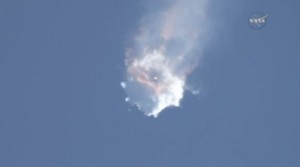An unmanned Space Exploration Technologies rocket exploded about two minutes after liftoff from Florida on Sunday, destroying a cargo ship bound for the International Space Station in the latest in a string of mishaps in supplying the orbiting outpost.

SpaceX rocket supplying space station explodes after launch
An unmanned SpaceX's Falcon 9 rocket broke up on Sunday morning just minutes after liftoff, destroying the supplies it was carrying to the International Space Station.The 208-foot-tall (63-meter) rocket, built and flown by the company known as SpaceX that is owned by technology entrepreneur Elon Musk, had previously made 18 successful launches since its 2010 debut. Those included six cargo runs for NASA under a 15-flight contract worth more than $2 billion.
The accident soon after liftoff from Cape Canaveral Air Force Station was the second successive botched mission to resupply the space station. A Russian Progress cargo ship failed to reach the outpost in April following a problem with its Soyuz launcher. Russia plans to launch a replacement capsule on Friday.
Only SpaceX’s Dragon capsules, however, return cargo and critical experiment results back from the station. The company’s next supply run for NASA had been targeted for September, but the launch schedule is likely to be revised.
The explosion also marks a setback for SpaceX, which was poised to compete for the first time against United Launch Alliance, a joint venture of Lockheed Martin Corp (LMT.N) and Boeing Co (BA.N) and the current sole launch provider for military and spy satellite launches, to launch a GPS III satellite.
Musk said on Twitter: “Falcon 9 experienced a problem shortly before first stage shutdown. Will provide more info as soon as we review the data.”
A spokesman for the company had no immediate further comment.
It was not immediately clear if the rocket broke apart on its own, or if Air Force range safety officers detonated explosives on the rocket, part of a system to ensure wayward boosters do not impact populated areas, NASA said.
Air Force officials were not immediately available to comment.
The crew – two Russian cosmonauts and an American astronaut – on the International Space Station has about four months of food and supplies on board, so the accident does not pose an immediate problem for them.
However, NASA’s second cargo transporter, run by Orbital ATK (OA.N), remains grounded following a launch accident in October.
EQUIPMENT, FOOD, EXPERIMENTS LOST
SpaceX lost contact with the Falcon 9 about 2 minutes and 19 seconds after liftoff, NASA launch commentator George Diller said.
“It’s not clear yet from the data what happened. They are beginning to play back video to look and see if there are any indications in the video what may have happened,” he said.
The accident occurred just before the rocket was to discard its first stage two minutes 39 seconds after liftoff.
Despite the explosion, one SpaceX customer voiced support in the company and the Falcon 9.
“One inevitable failure for such a young system should not in any way shake anyone’s faith in the rocket or the team. What’s amazing is that it took this long to happen,” said Mike Gold, business operations director with Nevada-based Bigelow Aerospace.
The spacecraft lost on Sunday carried 5,461 pounds (2,477 kg) of food, clothing, equipment and science experiments for the station, a $100 billion research laboratory that flies about 260 miles (420 km) above Earth.
The gear included the first of two docking systems for space taxis under development by SpaceX and Boeing (BA.N) to park at the station. NASA hopes to turn over crew transportation to the U.S. companies before the end of 2017, breaking Russia’s monopoly.
Including its station cargo runs for NASA, SpaceX has a backlog of nearly 50 missions, worth more than $7 billion, including dozens of commercial communications satellites. The company last month won U.S. Air Force certification to fly military and national security missions on the Falcon 9.
SpaceX holds a second NASA contract, worth up to $2.6 billion, to upgrade its Dragon capsule to fly astronauts to the station. Boeing’s contract is worth up $4.2 billion.
In addition to its launch pad at Cape Canaveral Air Force Station, SpaceX leases one of the mothballed space shuttle launch pads at the adjacent Kennedy Space Center and is building a new launch site in Texas.
The company has also flown once from a launch pad at Vandenberg Air Force Base in California.
Report by Reuters.
 CGTN America
CGTN America
